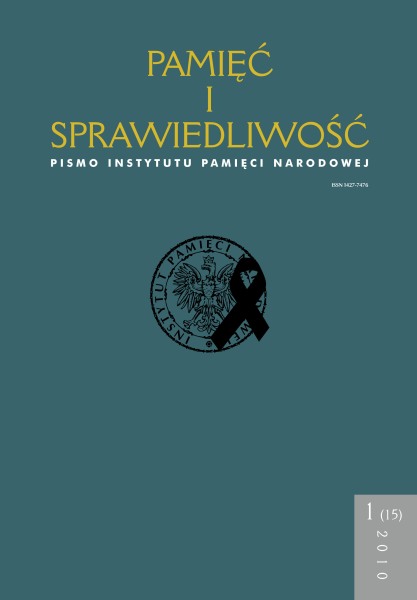Zbrodnia niewyjaśniona. O złożoności losów ludzkich w pierwszych latach powojennych na przykładzie zabójstwa Teodora Jałowskiego, funkcjonariusza Policji Państwowej i Milicji Obywatelskiej w Radomiu
Pamięć i Sprawiedliwość, Tom 15 Nr 1 (2010), strony: 309-323
Data publikacji: 2010-06-30
Abstrakt
The article presents the results of thorough research on an attempt to explain the circumstances of Teodor Jałowski’s murder in April 1947 who was an officer of National Police Forces during Second Polish Republic and Citizens’ Militia in the beginning of People’s Republic of Poland. The problem of verification and the following discussion of the circumstances of his death have been an opportunity to publish this material. Family ties with the character of this work – my grandfather – have been the reason for endeavoring to uncover the family mystery.
Archival material collected by the author enables to trace the description of 13 April 1947 event concerning the murder of Teodor Jałowski in a fairly detailed way. Existing archives of UB and Citizens’ Militia repressive forces are the basis of reference in this material as they provide an authentic picture of that event.
The article includes several authentic descriptions of security apparatus which was created after the liberation of Radom by the Soviet Union army and soon subordinated to NKVD. Existing UB reports as well as those of Citizens’ Militia Headquarters in the County of Radom (Komenda Powiatowa MO) verified in the text question the circumstances of the death of Jałowski presented at the time of People’s Republic of Poland, until 1989 to be exact.
At the time of People’s Republic of Poland Second Lieutenant Tadeusz Zieliński “Igła”, who was a leader of an underground group struggling for independence in the region of Kielce and in places surrounding Radom, was considered, together with his people, to be responsible for the death of Jałowski. In the given
period of time a substantial body of literature confirmed this opinion and placed Jałowski as a victim of military underground groups acting in the region in works by S. Skwarek and r. Halaba.
A detailed archival study of existing documents as well as meetings with still living eye witnesses remembering that tragic 13 April 1947 event deny findings revealed before 1989. The successful attempt to prove that Jałowski was not killed by the group led by “Igła” showed a misleading picture of the lists of victims, who died or were murdered in the post-war period, constructed at the time of People’s Republic of Poland. Enlisting Jałowski as a victim of anti-communist underground was undeniably unreasonable.
 Język Polski
Język Polski
 English
English
 Deutsch
Deutsch
 Français (France)
Français (France)
 Italiano
Italiano
 Русский
Русский


 PDF
PDF
